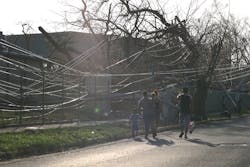Thousands of employees from electrical distributors, electrical manufacturers, independent manufacturers’ reps, electrical contractors and utility linemen left their homes and families to help others recover from the three hurricanes that recently caused so much devastation.
They were on the front line of the restoration efforts, handling the local logistics of getting products into flooded areas and getting power restored as fast as possible. The enormous scale of the storm damage was as big as anything the industry has ever seen. In the Sunshine State, at one time over 4 million customers were without power. The International Brotherhood of Electrical Workers (IBEW) said its union members were among the 60,000 line workers, tree trimmers and support staff from 250 utilities that helped restore power to the state.
A press release from Florida Power & Light (FPL) summarized the damage: “The powerful storm spawned tornadoes, uprooted large trees, transformed roads into rivers, flooded isolated areas, tore roofs off homes and businesses, and created salt contamination that damaged electrical equipment and left millions of Floridians in the dark.
“FPL assembled and pre-positioned the largest restoration workforce in U.S. history — and then continued to amass an army that at its peak numbered more than 28,000 hardworking men and women from 30 states and Canada who worked around the clock to get our communities back to normal.”
Along with the mobilization of the nation’s utility line workers to help out in Texas and Florida, you can bet that the electric power industry’s specialty distributors were also busy. As part of their storm restoration program, members of the North American Association of Utility Distributors (NAAUD), work 24/7 to provide member companies in affected areas with access to more than $180 million in inventory of utility products, including material reserved for storm emergencies. And as you will learn in Executive Editor Doug Chandler’s cover story, “Storm Season” (page 12), some electrical distributors had disaster recovery plans in place and were prepping their locations well in advance of the storms.
There were all sorts of examples of the electrical industry helping on the personal level, too. For instance, the folks from the Burrus & Matthews rep agency in Texas cooked steaks for the employees at one of the branches of Wholesale Electric Supply of Houston because a third of their employees were flooded out of their homes.
EW’s editors heard the same sort of stories in the aftermath of Hurricane Andrew in 1992, Hurricane Katrina in 2005, and the severe flooding last year in Louisiana, when a “Cajun Navy” of private citizens went house-to-house to rescue neighbors. Good-hearted Cajuns drove over to the Houston area with their boats after the hurricane to do the same for people there.
And when I think of roles local electrical distributors, reps and manufacturers have played in the aftermath of other disasters, I will never forget how some New York area distributors helped out on 9/11. Kennedy Electrical Supply Corp. had a delivery truck near the World Trade Center when the planes hit, and they used that vehicle to help evacuate people from the area, some clinging to the bumpers as they drove out of the city.
Jeff Birnbaum of Broadway Electrical Supply, a first responder in his Long Island community, raced to the World Trade Center from his company’s branch near Manhattan’s Union Square, and got trapped in a parking garage when the World Trade Center’s North Tower fell on it. Guided only by the light of his pager, he crawled out of the rubble to provide what assistance he could on the scene.
Be proud you work in an industry that so often goes above and beyond to help others in natural disasters and other times of crisis.
About the Author
Jim Lucy
Editor-in-Chief of Electrical Wholesaling and Electrical Marketing
Jim Lucy has been wandering through the electrical market for more than 40 years, most of the time as an editor for Electrical Wholesaling and Electrical Marketing newsletter, and as a contributing writer for EC&M magazine During that time he and the editorial team for the publications have won numerous national awards for their coverage of the electrical business. He showed an early interest in electricity, when as a youth he had an idea for a hot dog cooker. Unfortunately, the first crude prototype malfunctioned and the arc nearly blew him out of his parents' basement.
Before becoming an editor for Electrical Wholesaling and Electrical Marketing, he earned a BA degree in journalism and a MA in communications from Glassboro State College, Glassboro, NJ., which is formerly best known as the site of the 1967 summit meeting between President Lyndon Johnson and Russian Premier Aleksei Nikolayevich Kosygin, and now best known as the New Jersey state college that changed its name in 1992 to Rowan University because of a generous $100 million donation by N.J. zillionaire industrialist Henry Rowan. Jim is a Brooklyn-born Jersey Guy happily transplanted with his wife and three sons in the fertile plains of Kansas for the past 30 years.
